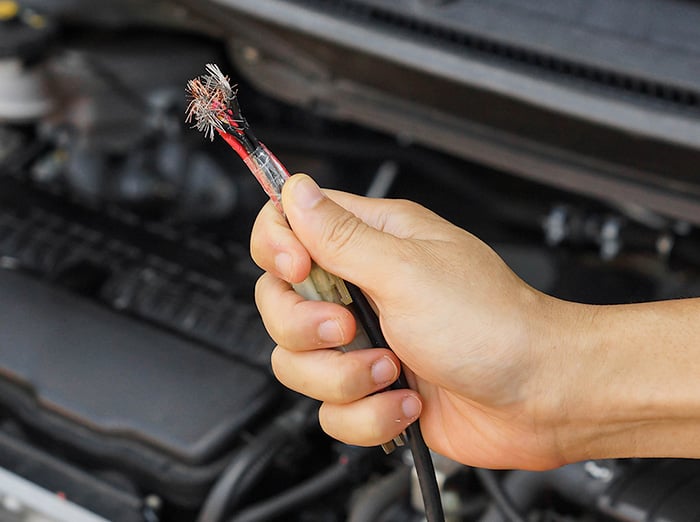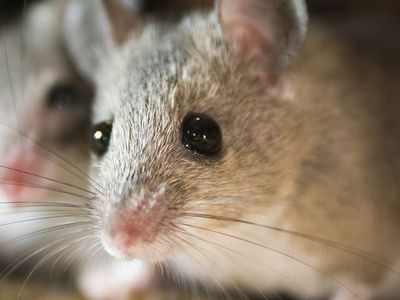Mice and rats have remarkable abilities that make them difficult to keep out of your home. They can climb walls, trees, and even the exteriors of buildings using their sharp claws. Their agility allows them to run along power lines at night, much like squirrels do during the day. A rat can squeeze through a gap as small as a quarter, and a mouse can fit through a space as small as a dime. Additionally, their strong teeth allow them to gnaw through materials, creating larger openings. These traits make it easy for rodents to infiltrate your garage if you’re not proactive. In this article, we’ll explore how you can prevent them from getting in.
Let’s examine what may lead to a garage rodent problem, discuss what Hampton Roads homeowners can do to prevent it, and share when to contact the Getem Services team for help.

What attracts mice and rats to your garage?
Before mice or rats get in, they start by exploring the exterior of your home. If you have attractants near potential entry points into your garage, a problem may start. Here are a few examples of what might bring rodents too close for comfort:
- An overflowing trash receptacle near your garage door or the exterior door that leads into your garage
- A pile of cardboard or other debris
- Nuts on the ground beneath a tree positioned near your garage
- Bird seed on the ground beneath a feeder
- A puddle running along your exterior where the gutter system is damaged
- A bowl of pet food sitting near a garage entry
- Broken crawl space door
Food, water, and clutter can draw mice or rats near your garage. Once there, they may find a way in simply because they’re continually exploring.
How do rodents get into your garage?
The most apparent entry is the sweep underneath your garage door. If there is a small gap, a rodent may exploit it. Sweep replacement can mitigate the threat of rodent infestation, but your garage door sweep is far from the only entry point for a rodent. Here are a few more to consider:
- A damaged sweep on the exterior door
- A rotted point in the frame around the exterior door
- A hole that leads into the exterior door frame or wall void of your garage
- A damaged screen and window pane of a garage window
- An open garage door
These are the common ways mice and rats get into garages. Once inside, they may poke around and go right back out. Let’s look at what might make them want to stay.
Why rodents might stay once they get in
Rodents look for secluded nesting sites. They may nest in a storage space under the stairs leading up to the home's entry door. They may nest in a storage space above. They’ll get into junk piles. They’ll enter wall voids, such as a damaged wall outlet or a gap around the garage door pull mechanism. They’ll enter a stored vehicle and nest inside seat cushions or under the hood. Most of the time, rodents find their way from garages to more secluded spaces, like attics, if they can find (or make) a route.
How to keep rodents out of your garage
The strategy for keeping mice and rats out of your garage is simple. Address attractants and potential entry points. Here are some examples:
- Manage trash to prevent smells that attract rodents.
- Avoid overfilling, and keep trash receptacles covered.
- Keep cardboard and other debris in covered bins until you dispose of it.
- Rake up nuts or fruit.
- Move bird feeders away from your exterior.
- Repair your gutter system to avoid ground saturation and prevent puddles from forming.
- Feed your dog or cat indoors.
- Repair garage and exterior door sweeps.
- Update the weatherstripping on your exterior doors.
- Seal gaps or holes in window and door frames.
- Fill in structural cavities with expanding foam or cover with wire mesh.
- Keep your garage door closed while you are out, particularly at night.
Routinely inspect your garage for warning signs of rodent activity as you work to keep these pests out. Check for:
- Black droppings
- Black grease marks on baseboards or surfaces
- Gnaw marks or holes
- Soft materials balled up in a hidden place
- The scent of urine
- The sound of movement
- Vehicle damage
When you detect these signs, contact Getem Services for a rodent inspection. Available in Norfolk, Virginia Beach, Chesapeake, and throughout Hampton Roads, our comprehensive rodent control services start with a thorough inspection, and then, based on our findings, we’ll develop a customized treatment plan that may include:
- Interior rodent traps
- Exterior rodent bait stations
- Rodent exclusion services
- Follow-up visits, as needed
When to call a professional about mice or rats
Should you wait until rodents have moved into your garage before you contact our locally owned and family-operated pest control company? No. In fact, we don’t recommend waiting. Preventing rodents through routine and ongoing home pest control services is far more effective. Our quarterly pest control plan includes services that proactively prevent rodent and insect infestations and include:
- Exterior pest treatment
- Interior service, if necessary
- Spider web removal
- Wasp nest removal (up to one story)
- Installation and maintenance of rodent bait stations
The best defense is a good offense. Contact your Getem Services team today to get started with a plan to keep mice, rats, ants, spiders, centipedes, and other house-infesting pests out of your home.

























